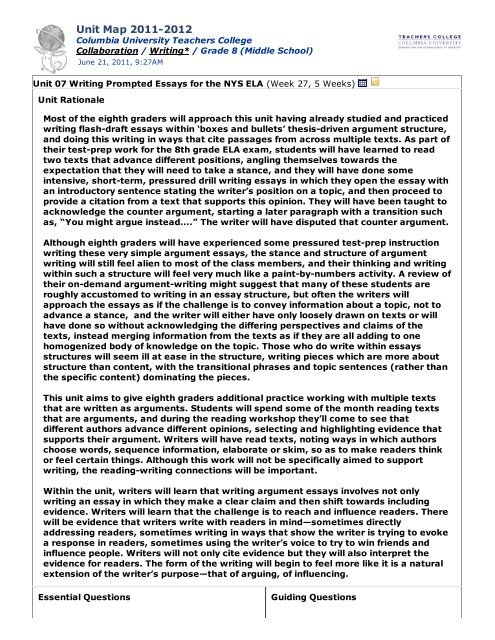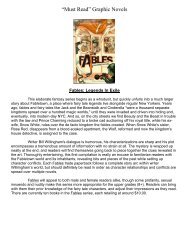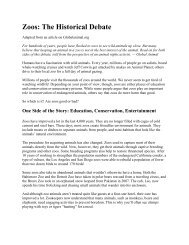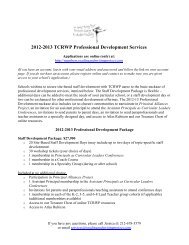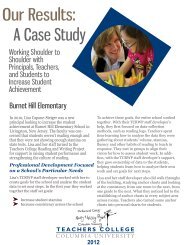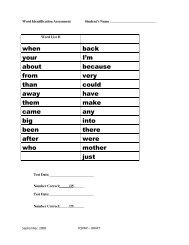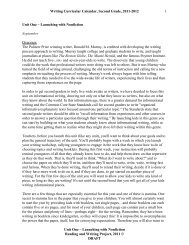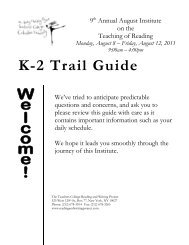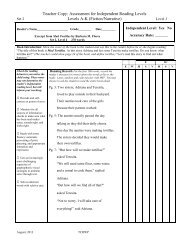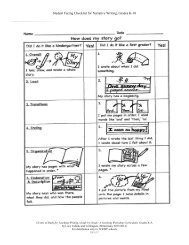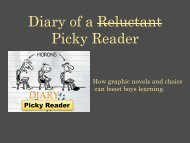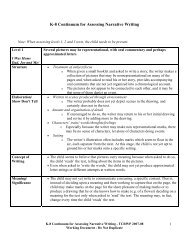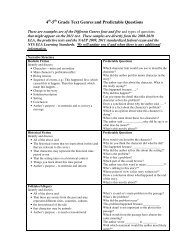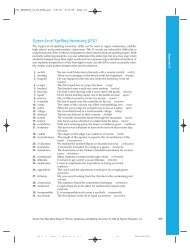Unit Map 2011-2012 - The Reading & Writing Project
Unit Map 2011-2012 - The Reading & Writing Project
Unit Map 2011-2012 - The Reading & Writing Project
You also want an ePaper? Increase the reach of your titles
YUMPU automatically turns print PDFs into web optimized ePapers that Google loves.
<strong>Unit</strong> <strong>Map</strong> <strong>2011</strong>-<strong>2012</strong>Columbia University Teachers CollegeCollaboration / <strong>Writing</strong>* / Grade 8 (Middle School)June 21, <strong>2011</strong>, 9:27AM<strong>Unit</strong> 07 <strong>Writing</strong> Prompted Essays for the NYS ELA (Week 27, 5 Weeks)<strong>Unit</strong> RationaleMost of the eighth graders will approach this unit having already studied and practicedwriting flash-draft essays within ‘boxes and bullets’ thesis-driven argument structure,and doing this writing in ways that cite passages from across multiple texts. As part oftheir test-prep work for the 8th grade ELA exam, students will have learned to readtwo texts that advance different positions, angling themselves towards theexpectation that they will need to take a stance, and they will have done someintensive, short-term, pressured drill writing essays in which they open the essay withan introductory sentence stating the writer’s position on a topic, and then proceed toprovide a citation from a text that supports this opinion. <strong>The</strong>y will have been taught toacknowledge the counter argument, starting a later paragraph with a transition suchas, “You might argue instead….” <strong>The</strong> writer will have disputed that counter argument.Although eighth graders will have experienced some pressured test-prep instructionwriting these very simple argument essays, the stance and structure of argumentwriting will still feel alien to most of the class members, and their thinking and writingwithin such a structure will feel very much like a paint-by-numbers activity. A review oftheir on-demand argument-writing might suggest that many of these students areroughly accustomed to writing in an essay structure, but often the writers willapproach the essays as if the challenge is to convey information about a topic, not toadvance a stance, and the writer will either have only loosely drawn on texts or willhave done so without acknowledging the differing perspectives and claims of thetexts, instead merging information from the texts as if they are all adding to onehomogenized body of knowledge on the topic. Those who do write within essaysstructures will seem ill at ease in the structure, writing pieces which are more aboutstructure than content, with the transitional phrases and topic sentences (rather thanthe specific content) dominating the pieces.This unit aims to give eighth graders additional practice working with multiple textsthat are written as arguments. Students will spend some of the month reading textsthat are arguments, and during the reading workshop they’ll come to see thatdifferent authors advance different opinions, selecting and highlighting evidence thatsupports their argument. Writers will have read texts, noting ways in which authorschoose words, sequence information, elaborate or skim, so as to make readers thinkor feel certain things. Although this work will not be specifically aimed to supportwriting, the reading-writing connections will be important.Within the unit, writers will learn that writing argument essays involves not onlywriting an essay in which they make a clear claim and then shift towards includingevidence. Writers will learn that the challenge is to reach and influence readers. <strong>The</strong>rewill be evidence that writers write with readers in mind—sometimes directlyaddressing readers, sometimes writing in ways that show the writer is trying to evokea response in readers, sometimes using the writer’s voice to try to win friends andinfluence people. Writers will not only cite evidence but they will also interpret theevidence for readers. <strong>The</strong> form of the writing will begin to feel more like it is a naturalextension of the writer’s purpose—that of arguing, of influencing.Essential QuestionsGuiding Questions
How do I create an argument aboutsomething I feel strongly about, evaluatingand citing the research sources I use, andstating and refuting the counterargument(s)?Big Ideas/Enduring Understandings- Gathering facts and statistics to helpyour claim- Looking for different perspectives andlenses on their topic- Revising confirming or adding or whatthey are thinking- Making your claim and thenacknowledging the other side thecounterclaim to make your claim strongerHow do we create morecompelling essay’s that createa urgency to take your sideHow do we gather factsshowing many differentperspectivesHow can we evaluate andinterpret information andperspectiveCommon Core Standards and IndicatorsNY: CCLS:English Language Arts 6–12, NY: 8th Grade , <strong>Reading</strong>: Informational Text8. Delineate and evaluate the argument and specific claims in a text, including the validity ofthe reasoning as well as the relevance and sufficiency of the evidence.8. Delineate and evaluate the argument and specific claims in a text, assessingwhether the reasoning is sound and the evidence is relevant and sufficient; recognizewhen irrelevant evidence is introduced.NY: CCLS:English Language Arts 6–12, NY: 8th Grade , <strong>Writing</strong>Text Types and Purposes1. Write arguments to support claims in an analysis of substantive topics or texts, using validreasoning and relevant and sufficient evidence.1. Write arguments to support claims with clear reasons and relevant evidence.1a. Introduce claim(s), acknowledge and distinguish the claim(s) from alternate oropposing claims, and organize the reasons and evidence logically.1b. Support claim(s) with logical reasoning and relevant evidence, using accurate,credible sources and demonstrating an understanding of the topic or text.1c. Use words, phrases, and clauses to create cohesion and clarify the relationshipsamong claim(s), counterclaims, reasons, and evidence.1d. Establish and maintain a formal style.1e. Provide a concluding statement or section that follows from and supports theargument presented.ContentA. Literary toolsStudents should have developed and explored essay writing techniques (thesis,claim counterclaim etc.).Students should have experience with finding details to prove what they aretrying to sayStudents should have familiarity with the writing process and be accustomed tocollecting many seed ideas, rehearsing different ideas, drafting ideas in variousways, and revising drafts.Students should be familiar with essay structure and format
SkillsKey Terms/VocabularyNevertheless, vignetteBut, ContrastingHowever,Despite thisFurthermoreAchievementsLimitationsConsequencesSequenced Learning Plans/Mini LessonsAssessmentsGuiding Questions / Bend One:What do we believe and why?How can essayists take research notesin precise, thoughtful ways to researchour claim?How can we use what we have learnedacross the years to help us take notesin many different ways for manydifferent purposes?How can we talk back to what we arewriting or reflect on how our researchis changing our thinking, about ourimportant claims by thinking aboutwhat we recorded?How do we talk back to our notes?Guiding Questions / Bend Two:How do we know what’s important andwhy it is important to write down?How do we paraphrase?How do we take notes from a video clipor from the webHow can we group our notes so theymake sense?How do we look at all the differentsides of a topic to make our claimstronger?Guiding Questions / Bend Three:How do we zoom in on a part ofresearch and really focus it.How can we ask questions such as“What is this author trying to make mefeel about the topic? Why is the author
feel about the topic? Why is the authortrying to make me feel this?” In ournotes, we note and compare thefeelings that different texts evoke andwe list the craft choices or illustrationdetails of each text that contribute tomaking us feel this way.So what are all our notes really saying?How do researchers develop our ownclaim on topicsHow can essayists try out severalpossible claims, and rehearse thosewith a partnerGuiding Questions / Bend Four:How do we draft our persuasive essaywhat is our angle claim counterclaimHow can insert anecdotes as evidenceto help our claim become strongerHow can we insert quotes expertsmake and describe their expertiseHow can we find possible evidence tosupport the opposite side’s argument.We jot all possible evidence that maysupport the counterclaim, adding atransition like Nevertheless, But,However, Despite this…torefuteeachargumentHow can essayists develop a paragraphor two in which we acknowledge anddiscredit the counterclaim.Guiding Questions / Bend Five:How can we study mentor texts to helpour essaysHow can we include a true story intoour essaysRepeat lessonHow can we use domain vocabulary togrow our essaysHow can we write out thesis to catchthe readers attentionHow do we write a conclusion catchythe reader wanting moreCreating a blog or a facebookdiscussion, or podcastEnd of <strong>Unit</strong> (summative)-At the end of thisunit, students will understand that…That there are many sides to a storyArguments are won based on facts anddetails
Revision on what you belive could happenthrough researchHow do I catch the audiences attention tomy causeGoing deeper into essay workOur government went through manyrevisions before it became three branchesResourcesTexts Used(fiction, non-fiction, on-line, media, etc...)Just Right Leveled Books, Social Studies resource books, Atlas and text books, SocialStudies core curriculum books, Wikipedia, National Sports League website, CooperstownBaseball Hall of Fame on Skype, Story works, Cobblestone, TimeWebsites and Web-tools usedhttp://www.cmom.org/ Researchhttp://www.dirksencenter.org/print_programs_CongressClassroom.htm Researchhttp://www.theconstitutionworks.org/ Researchhttp://www.facinghistory.org/resources/lessons_units ResearchBlog makerFacebookDesignerField-trip/Lab ExperiencesGraphs and Picture Support Jack Dawes, Gotham Center for New York History, Documentsfrom witnessesDifferentiated Instructions: Small Group


